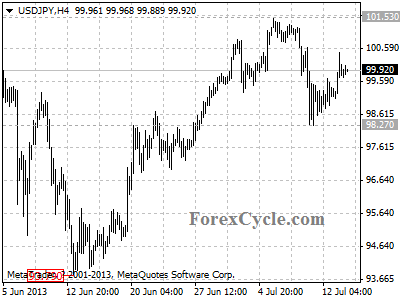London Gold Market Report
from Adrian Ash
BullionVault
Monday, 15 July 08:05 EST
LONDON prices for physical gold held little changed Monday morning, edging lower from the best weekly finish in three as new data showed China’s economic growth slowing but retail sales rising sharply.
Asian and European stock markets ticked higher, but commodity prices fell back, with crude oil dropping 0.7%.
A rise in the US Dollar saw gold for Euro and UK investors briefly touch three- and four-week highs respectively.
Silver prices ticked down to $19.84 per ounce, some 3.4% higher from Monday lunchtime last week.
“There’s support from Asian interest in gold,” says Standard Bank’s weekly market positioning note, citing reports of “strong physical buying in China.
“Reportedly, some retailers ran out of gold bars and gold jewellery. Confirming this are the physical flows we have seen in Asia.”
“Investors here remained big buyers this year,” says strategist Fu Peng at the state-owned Galaxy Futures Co. brokerage in Beijing, commenting to Bloomberg on strong deliveries of physical gold from the Shanghai Gold Exchange.
New data Monday showed the SGE supplying 1,098 tonnes of gold in the first half of 2013, more than 94% of last year’s entire total.
China’s economy meantime grew by 7.5% in the second quarter, the official data agency said this morning, the slowest rate in three years.
Industrial production slowed to 8.9% growth.
Retail spending, in contrast, grew faster than analysts forecast at 13.3% year-on-year.
“Household consumption is very low as a proportion of GDP,” said China specialist and Peking University professor Michael Pettis in an interview with the Financial Times last week.
“There’s a myth this is because households save a large proportion of their income,” he explained. “But it’s because the household share of GDP is very low.”
To rebalance away from exports and government investment without causing civil strife, Pettis believes, Beijing has to keep household income growing strongly whilst total GDP slows towards 3% annual growth.
“It’s possible but difficult.”
For Renminbi buyers, the price of gold fell 24% in the second quarter of 2013.
Shanghai premiums on gold bullion today held more than $30 per ounce above the international benchmark set by London pricing.
“The strength in China and India gold premiums,” says a note from bullion market-makers Deutsche Bank, “[plus] the recent move higher in gold lease rates and central bank gold buying indicate physical demand for gold may provide some support in the near term.”
Lease rates to borrow gold have risen this month, whilst the “swap rate” – offered by large gold holders in exchange for cash, which can earn them interest and then be swapped back at the end of the contract – has gone negative, also forcing would-be borrowers to pay more.
But whether “from miners’ hedges or from investors rolling short positions,” says a note from another London market maker’s trading desk, “the move on gold rates (swaps down, lease up) have been well documented and is clearly the result of that activity involving bearish strategies.”
“Although gold lease rates [have] moved moderately higher,” adds Jonathan Butler at Japanese conglomerate Mitsubishi, “the effect of this is insignificant in an historical context and reflects a short term rebalancing of ‘paper’ and physical gold demand.”
Latest data from US regulator the CFTC showed Friday that speculative traders cut their bullish position to new multi-year lows as a group.
Taking all professional traders’ bearish bets away from their bullish bets, so-called “net speculative length” fell below the equivalent of 87 tonnes in the week-ending last Tuesday.
That’s a drop of 82% from the start of the year, and more than 90% below the record peak of August 2011 – hit just before the gold price reached its record high of $1920 per ounce.
This latest drop in speculative length came after stronger-than-expected US jobs data, says Standard Bank’s commodity team, calling the 11.1 tonnes lost a “more muted reaction” than previous “Fed-related” sell offs
“[This] points to a market that is becoming more comfortable with the prospect of a paring of Fed quantitative easing.”
Meantime in Turkey today – the world’s 4th largest gold buying nation – central bank chief Erdem Basci it will consider raising Lira interest rates at its next meeting, as well as extending easier credit to export companies, to defend the country against sharp outflows of foreign investment cash.
Last Monday alone, the State Bank sold dollars to buy $2.25 billion of Lira – spending some 5% of its FX reserves – as the Turkish currency fell to new record lows, down 20% since February.
With Basci blaming “elevated global uncertainty and volatility” today, the Lira rose from fresh all-time lows.
Since late 2011, Turkey has risen from 26th to 13th place amongst central-bank gold bullion holders by allowing commercial banks to hold some of their reserve requirements in physical gold, gathered in turn from household gold depositors.
The domestic gold price for Turkish investors has dropped 19% so far in 2013.
Adrian Ash
BullionVault
Gold price chart, no delay | Buy gold online
Adrian Ash is head of research at BullionVault, the secure, low-cost gold and silver market for private investors online, where you can buy gold and silver in Zurich, Switzerland for just 0.5% commission.
(c) BullionVault 2013
Please Note: This article is to inform your thinking, not lead it. Only you can decide the best place for your money, and any decision you make will put your money at risk. Information or data included here may have already been overtaken by events – and must be verified elsewhere – should you choose to act on it.










